#bunchy carter
Text

The Courageous Sacrifice of Bunchy Carter and John Huggins: Inspiring the Fight for Justice
#black power#black excellence#black panther party#black history#black tik tok#tik tok#bunchy carter#john huggins#alprentice Bunchy Carter#Bunchy Carter#civil rights#civil rights movement#black leaders#black activism
33 notes
·
View notes
Text

At a Black Student Union meeting at UCLA's Campbell Hall on January 17, 1969, Bunchy Carter and John Huggins, another BPP member, were heard making derogatory comments about Karenga, the founder of Organization Us. Other versions mention a heated argument between Organization Us members and Panther Elaine Brown. An altercation ensued during which Carter and Huggins were shot to death. BPP members originally insisted that the event was a planned assassination, claiming that there was a prior agreement that no guns would be brought to the meeting, that BPP members were not armed, and that Organization Us members led by Ron Karenga were.
Organization Us members maintained the meeting was a spontaneous event. Former BPP deputy minister of defense Geronimo Pratt, Carter’s head of security at the time, later stated that rather than a conspiracy, the UCLA incident was a spontaneous shootout. The person who allegedly shot Carter and Huggins, Claude Hubert, was never found.
During the Church Committee hearings in 1975, evidence came to light that under the FBI's COINTELPRO actions, FBI agents had deliberately fanned flames of division and enmity between the BPP and Organization Us. Death threats and humiliating cartoons created by the FBI were sent to each group, made to look as if they originated with the other group, with the explicit intention of inciting deadly violence and division.
Following the UCLA incident, brothers George and Larry Stiner and Donald Hawkins turned themselves in to the police, who had issued warrants for their arrests. They were convicted for conspiracy to commit murder and two counts of second-degree murder, based on testimony given by BPP members. The Stiner brothers both received life sentences and Hawkins served time in California’s Youth Authority Detention.
america has NEVER been great. never ever.
510 notes
·
View notes
Photo

The 9 Livez of the Black Pantherz In "The Nine Lives of the Black Pantherz," Revolutionary prison artist Joedee tells us in his work: A Black Pantherz Sprite Neva Diez ...The 9 Livez of the Black Pantherz He goes on and lays out in another piece of written text, "The Assassination of the Black Panther Party," and list the names and year of their assassination, guilty of only standing up to white power and speaking, "I want for Blacks what you want for yourself!" Alprentice "Bunchy" Carter 1969 George Lester Jackson 1971 Jonathan Jackson 1970 "Lil Bobby" Hutton 1968 Huey Newton 1994 Hugo Yogi Pinell 2015 E * Geronimo Ji-Jiga Pratt 2011 Do you want more content like this? Follow us @Neojimcrowart #blackpanthers #blackpantherparty #blackpanther #GeorgeJackson #GeorgeJacksonUniversity #thenewjimcrow #jimcrow #abolition #neojimcrowart #art #prison #prisonart #blackartmatters #BlackLivesMatter #blackart #ados #blackartist #blackamerica #africanamericanart #africanamerican #africanamericanhistory #panafrica #africa #hiphopart #hiphopculture #hiphopblog #hiphopnation (at Campaign to End the New Jim Crow) https://www.instagram.com/p/CdaFr0bsQLp/?igshid=NGJjMDIxMWI=
#blackpanthers#blackpantherparty#blackpanther#georgejackson#georgejacksonuniversity#thenewjimcrow#jimcrow#abolition#neojimcrowart#art#prison#prisonart#blackartmatters#blacklivesmatter#blackart#ados#blackartist#blackamerica#africanamericanart#africanamerican#africanamericanhistory#panafrica#africa#hiphopart#hiphopculture#hiphopblog#hiphopnation
2 notes
·
View notes
Text
Events 1.17 (after 1945)
1945 – World War II: The Vistula–Oder Offensive forces German troops out of Warsaw.
1945 – The SS-Totenkopfverbände begin the evacuation of the Auschwitz concentration camp as the Red Army closes in.
1945 – Swedish diplomat Raoul Wallenberg is taken into Soviet custody while in Hungary; he is never publicly seen again.
1946 – The UN Security Council holds its first session.
1948 – The Renville Agreement between the Netherlands and Indonesia is ratified.
1950 – The Great Brink's Robbery: Eleven thieves steal more than $2 million from an armored car company's offices in Boston.
1950 – United Nations Security Council Resolution 79 relating to arms control is adopted.
1961 – U.S. President Dwight D. Eisenhower delivers a televised farewell address to the nation three days before leaving office, in which he warns against the accumulation of power by the "military–industrial complex" as well as the dangers of massive spending, especially deficit spending.
1961 – Former Congolese Prime Minister Patrice Lumumba is murdered in circumstances suggesting the support and complicity of the governments of Belgium and the United States.
1966 – Palomares incident: A B-52 bomber collides with a KC-135 Stratotanker over Spain, killing seven airmen, and dropping three 70-kiloton nuclear bombs near the town of Palomares and another one into the sea.
1969 – Black Panther Party members Bunchy Carter and John Huggins are killed during a meeting in Campbell Hall on the campus of UCLA.
1977 – Capital punishment in the United States resumes after a ten-year hiatus, as convicted murderer Gary Gilmore is executed by firing squad in Utah.
1981 – President of the Philippines Ferdinand Marcos lifts martial law eight years and five months after declaring it.
1991 – Gulf War: Operation Desert Storm begins early in the morning as aircraft strike positions across Iraq, it is also the first major combat sortie for the F-117. LCDR Scott Speicher's F/A-18C Hornet from VFA-81 is shot down by a Mig-25 and is the first American casualty of the War. Iraq fires eight Scud missiles into Israel in an unsuccessful bid to provoke Israeli retaliation.
1991 – Crown Prince Harald of Norway becomes King Harald V, following the death of his father, King Olav V.
1992 – During a visit to South Korea, Japanese Prime Minister Kiichi Miyazawa apologizes for forcing Korean women into sexual slavery during World War II.
1994 – The 6.7 Mw Northridge earthquake shakes the Greater Los Angeles Area with a maximum Mercalli intensity of IX (Violent), leaving 57 people dead and more than 8,700 injured.
1995 – The 6.9 Mw Great Hanshin earthquake shakes the southern Hyōgo Prefecture with a maximum Shindo of VII, leaving 5,502–6,434 people dead, and 251,301–310,000 displaced.
1996 – The Czech Republic applies for membership in the European Union.
1997 – Cape Canaveral Air Force Station: A Delta II carrying the GPS IIR-1 satellite explodes 13 seconds after launch, dropping 250 tons of burning rocket remains around the launch pad.
1998 – Clinton–Lewinsky scandal: Matt Drudge breaks the story of the Bill Clinton–Monica Lewinsky affair on his Drudge Report website.
2002 – Mount Nyiragongo erupts in the Democratic Republic of the Congo, displacing an estimated 400,000 people.
2007 – The Doomsday Clock is set to five minutes to midnight in response to North Korea's nuclear testing.
2008 – British Airways Flight 38 crashes short of the runway at Heathrow Airport, injuring 47.
2010 – Rioting begins between Muslim and Christian groups in Jos, Nigeria, results in at least 200 deaths.
2013 – Former cyclist Lance Armstrong confesses to his doping in an airing of Oprah's Next Chapter.
2013 – Shahzad Luqman is murdered by members of Golden Dawn in Petralona, Athens, leading the creation of new measures to combat race-based attacks in Greece.
2016 – President Barack Obama announces the Joint Comprehensive Plan of Action.
2017 – The search for Malaysia Airlines Flight 370 is announced to be suspended.
2023 – An avalanche strikes Nyingchi, Tibet, killing 28 people.
0 notes
Video
youtube
Slauson Village member on subsets, White conflict & Bunchy Carter during...
0 notes
Link
By Dulce Garcia
On Sunday, June 7, a “Community Caravan Against Police Terrorism” was held in Los Angeles. Hundreds of vehicles joined the historic protest caravan.
The caravan was hosted by Unión del Barrio and co-hosted by Struggle-La Lucha, the Harriet Tubman Center for Social Justice, Witness for Peace Southwest, the Socialist Unity Party, the Human Rights Alliance for Child Refugees and Families, and Frente Indígena de Organizaciones.
#Los Angeles#caravan#protest#JusticeForGeorgeFloyd#BlackLivesMatter#JailKillerCops#police brutality#racism#Union del Barrio#Struggle La Lucha#Bunchy Carter#Black Panthers#Indigenous#solidarity#socialism#communist#Black liberation#high school#students#Dulce Garcia
11 notes
·
View notes
Text

Bunchy Carter. Nipsey Hussle. Same hood, same heart, same message, 50 years apart.
#nipsey hussle#nipsey#bunchy carter#bunchy#the marathon continues#tmc#la#los angeles#slauson#crenshaw#crenshaw and slauson#hero#love#black panther party#bpp
347 notes
·
View notes
Photo
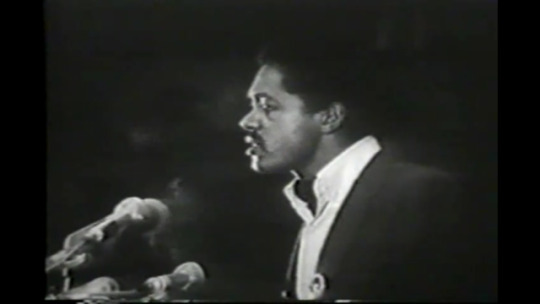

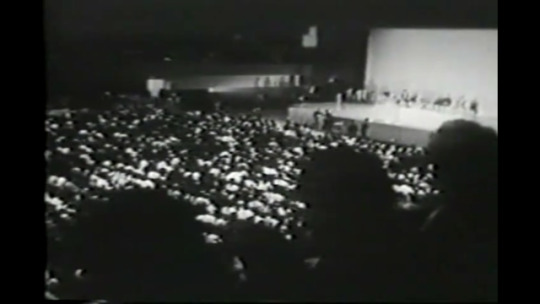




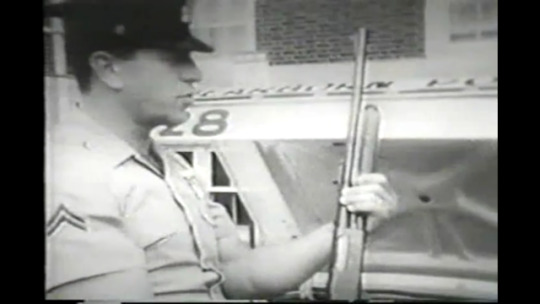
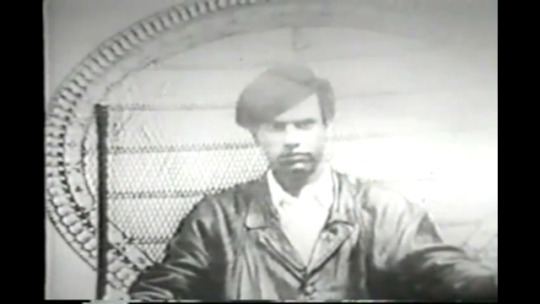
Black Panthers (1968) aka Free Huey documentary
#black panthers#huey newton#fred hampton#bunchy carter#john huggins#police violence#revolution#black power#civil rights#violence#murder#history#black history#nationalism#black panther party#bobby seale#socialism#philosophy#malcom x#african american history
38 notes
·
View notes
Quote
I sat down with former FBI agent Wes Swearingen, who explained just how far the FBI went to neutralize the black liberation movement, particularly the Black Panthers on the West Coast. He exposed the murder of Bunchy Carter in his interview, explaining how they not only wanted to neutralize Bunchy but to discredit him. In his own words, he said that the FBI originally planned for Bunchy to die in Watts in a drug-deal-gone-bad scenario, but — and these are his words — sometimes informants don’t do what you tell them to do. Instead, on January 17, 1969, Bunchy Carter was killed in Campbell Hall on the campus of UCLA. That revelation was definitely a smoking gun for me. Blacks in America have always been written off as conspiracy theorists, even though some of these things have manifested before our own eyes. But when we try to point some of these things out, they almost mockingly say that our accusations have no credibility, can’t be proved. The murder was not only a smoking gun, but a confirmation that behind the scenes, strings are definitely being pulled.
[Bone, “The Bastard Question”]
177 notes
·
View notes
Photo

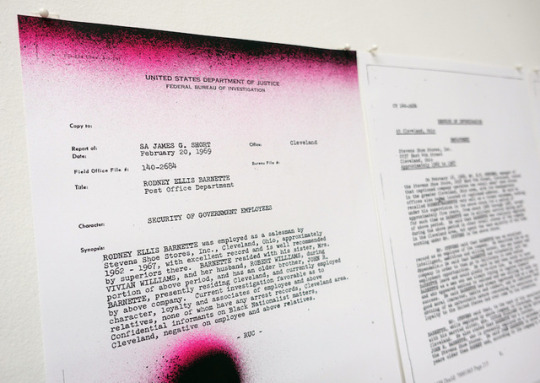
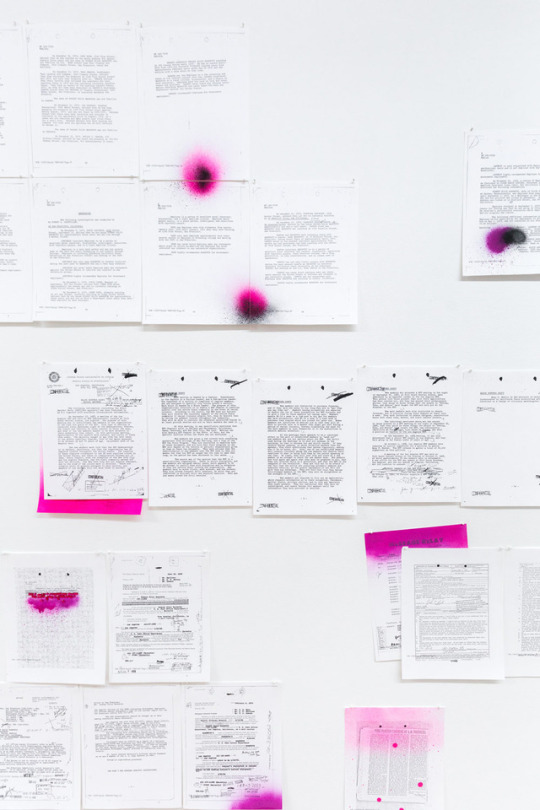

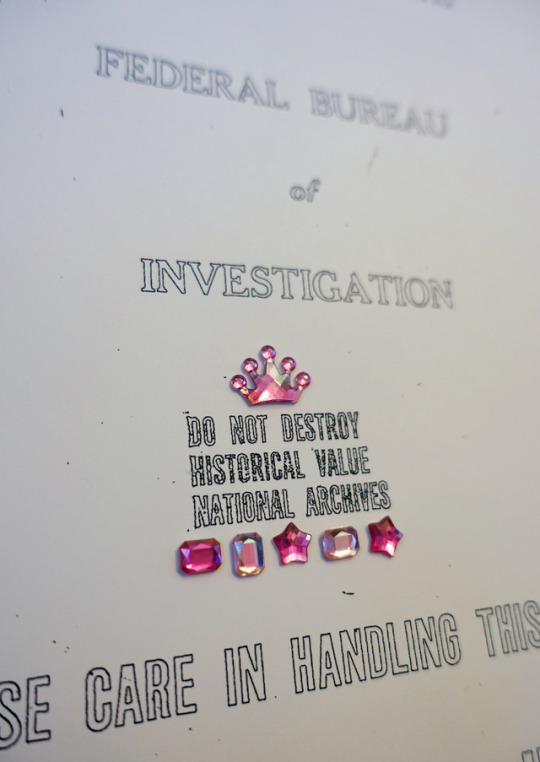


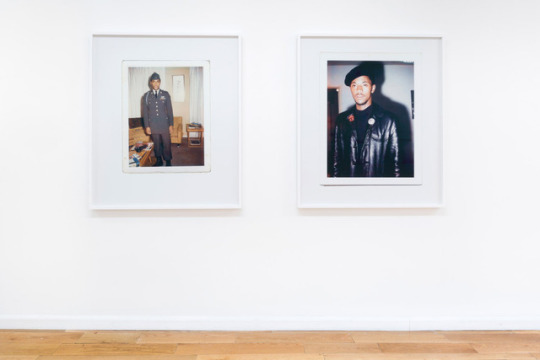
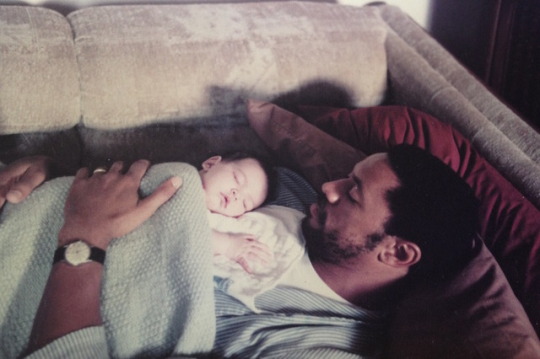
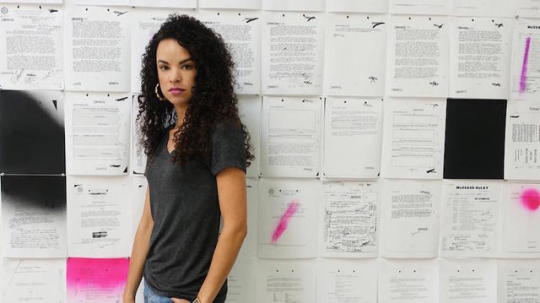
Sadie Barnette Reclaims Her Father’s Black Panther FBI File As Art
Artist Sadie Barnette’s family tree includes a 500-page FBI file. In 1968, the United States government placed her father, Rodney Barnette, under surveillance. For decades, his every daily detail was logged and noted. Family members, employers, even his former high school teachers were interrogated. The reason for the target on his back: Rodney was a founding member of the Compton, California chapter of the Black Panther Party for Self Defense.
In an era where J. Edgar Hoover’s FBI sought to actively, though covertly, criminalize and destroy the Panthers—and arguably any prominent or rising Black political leader—the elder Barnette was of hundreds of activists subject to state-sanctioned harassment and intimidation, their organizations infiltrated and discredited. Other revolutionaries were incarcerated; some were assassinated.
Growing up, Sadie Barnette’s father’s history was never a secret. It seems almost inevitable that the young artist whose work is dedicated to excavating the constructs of identity would turn her gaze to his FBI file, newly available through a Freedom of Information Act request. For Do Not Destroy, her first solo exhibition in New York City, Barnette reframes the pages of the dossier as a father-daughter conversation. With the intervention of her own visual presence—through unapologetically girly embellishments and abstractions—she subverts the government’s narrative with her own. The spurts of hot pink spray paint on black-and-white pages restore a sense of sinew and blood, returning a dignity of wholeness to the life described therein. And so, it is from an inheritance of being targeted and surveilled, that Barnette has grown a garden of reclamation.
Mass Appeal sat down with the Oakland-born artist to learn more.
Mass Appeal: Your family knows what it is like to be targeted, to be painted as a “terrorist.” What are some of your thoughts on the current administration’s rhetoric and actions in dehumanizing and criminalizing believers of Islam, refugees and the undocumented?
Sadie Barnette: One of the things that was really striking about my dad’s file was that my dad was fired from his job at the Post Office because of his involvement with the Panthers. But, the law used to get him fired was something that President Truman had put on the books. It was an Executive Order that talked about behavior unbecoming to a government employee. That’s what they used to get my dad fired because he was cohabitating with a woman who he wasn’t married to… That was behavior that was unbecoming of a government employee. But, the reason that law was put on the books was to get gay people out of government jobs. So it’s another one of those examples where people think “Oh, this law doesn’t affect me. I’m not Muslim. I’m not an immigrant. I’m not trans. This has nothing to do with me.” But a similar law or laws can be used to target whoever the government is considering inconvenient at the time or whoever is questioning things or fighting for their rights. That’s definitely something that we have to keep in mind today.
Was activism and an awareness beyond self-interest part of your birthright or did you come into your own political awakening?
It was always something I held in my heart… I looked at situations with systemic analysis. If the police beat someone up or say if somebody in the family didn’t have access to something that they needed, I would always see it through a lens of systemic problems in our country. When I was in high school, I was very aware that students were being criminalized and were being shuttled along this school-to-prison pipeline. So those things were always on my mind. And growing up in the Bay area, there is a lot of activism and systemic analysis.
How did that activism and analysis start to factor in or feed your artistic growth?
I think they definitely go hand-in-hand. All art is political even when it’s not. Because it’s still a political choice if you are choosing to ignore politics. Often times, just the act of making art or changing the way people think even if its meant as an act of poetry is inherently political. People need escape and fantasy and fiction and need to feel beautiful and seen and heard. So for me even in my work that isn’t directly talking about the FBI file, it is still a commitment to… The act of making art is still a commitment to humanity.
What prompted your dad to want to look at your father’s file, and then what prompted you to want to work with the material?
My dad always wondered what experiences were tied to his FBI surveillance, harassment and intimidation. He wanted the file and so filed a Freedom of Information Act request to get it. It took about four years to get the file. I’m not sure what at that exact moment made him want to really face what a lot of people don’t want to look at. It can be too painful. But, he knows that it is bigger than himself. He also was very lucky that he wasn’t assassinated at the time or thrown in jail. He really is a strong person that survived a lot and still is able to see the value in sharing his experiences. I’ve always been interested in telling the story of my parents and also the activism and the cultural outpourings of that time period. This just seemed like the perfect way to do that—using this file for good and reclaiming it.
Did you wrestle with how much of the file you should work with or alter or how much you should let it speak for itself?
I definitely had to wrestle with it. The fact that the project’s first debut was at the Oakland Museum for the Black Panther exhibit, All Power to the People: Black Panthers at 50 really helped give me confidence that this could be framed and contextualized properly because the show is really dedicated to talking about the full complexities of the Black Panthers, not just like the cool image or that kind of thing. So being included in the Oakland Museum exhibition was what really made me excited about making the final decisions as to how to use this material.
I think it will be the type of project that’ll be ongoing. I’m not the kind of artist that thinks this is the like the ultimate or some kind of end. It’s no [laughs] magnum opus—it’s ongoing. One of the things I value about being an artist is that you can be unsure. You can question and try things. I’m sure I will work in many ways with this file. At some point, I’d like to make a book project with it. My intention often when I’m making art is not about making things; it’s about seeing things. So, the re-framing, the juxtaposing of these files and just a few gesture on my part was really what I wanted to do to allow the pages to speak for themselves and then for the viewer to bring something new to it.
The work also calls into the conversation the political activists that were murdered. Others were arrested and some still incarcerated to this day. Is it imperative to you as we celebrate the 50th Anniversary of the Panthers?
Absolutely. It is hugely important. And I think it is something that we still don’t know enough about. There are a ton of names of people in my dad’s file who he knew, who were his mentors who were killed. John Huggins. Bunchy Carter. They were murdered at UCLA. It is a double tragedy if their lives were not only stolen and taken away from their families but that they are also not remembered in the historical consciousness.
Have you become a student of the era as a result?
Definitely. I’ve been reading several books. One is called The Burglary by Betty Medsger. She basically was one of the reporters to receive the first batch of stolen FBI files around 1972 from this small FBI office in Pittsburgh. These anti-war activists realized that the movement was being surveilled so heavily that the only way to expose what the FBI was actually doing was to break into this office. I’ve been learning a ton about J. Edgar Hoover. It’s amazing to think that these activists were just regular, hard-working people. They weren’t criminals, they were actually repelled by [the thought of] breaking into this office, but they knew it would be worse to let Hoover run the FBI unchecked and run democracy into the ground. The other book is Black Against Empire: The History and Politics of The Black Panther Party by Joshua Bloom and Waldo E. Martin, Jr.
What did working with this file teach or surprise you about your dad or by extension about yourself?
Well, it’s hard to say. I’m pretty close to my dad so most of the things I knew already. I definitely learned more about our government than I did about my family. Questioning the government, dissent, is legal. It is written into the Constitution. If the government isn’t working properly, then the people are to change it. But people who are in power want to protect their power. As a descendent of slaves and Native Americans in this country, I have never felt like we are included when they say “We the People.” I’ve never felt like this country was mine. My ancestors built this country, but it was never for them either. I’ve always felt that if this country was actually going to be for everyone, then we would have to first really face some things that people don’t want to talk about.
Do Not Destroy is on view through Saturday, February 18, 2017 at Baxter St at Camera Club of New York (126 Baxter St, NY).
#sadie barnette#do not destroy#j. edgar hoover#j edgar hoover#fbi#federal bureau of investigation#black panther party#black panther party for self defense#compton california#california#all power to the people: black panthers at 50#all power to the people black panthers at 50#john huggins#bunchy carter#the burglary#betty medsger#black against empire: the history and politics of the black panther party#black against empire the history and politics of the black panther party#joshua bloom#waldo e. martin jr.#waldo e martin jr#mass appeal#american history#black history#history#art#black art#baxter st#rodney barnette#domestic terrorism
41 notes
·
View notes
Text

An FBI memo dated November 29, 1968 described a letter that the L.A FBI office intended to mail to the Black Panther Party office. The letter. was made to appear as if it had come from the Us Organization, describing fictitious plans by Us to ambush BPP. The FBI memo stated that "It is hoped this counterintelligence measure will result in an 'Us' and BPP vendetta."
—At a Black Student Union meeting at UCLA's Campbell Hall on January 17, 1969, Bunchy and John, another BPP member, were heard making derogatory comments about Karenga, the founder of Organization Us. Other versions mention a heated argument between Organization Us members and Panther Elaine Brown. An altercation ensued during which Carter and Huggins were shot to death. BPP members originally insisted that the event was a planned assassination, claiming that there was a prior agreement that no guns would be brought to the meeting, that BPP members were not armed, and that Organization Us members were.
Organization Us members maintained the meeting was a spontaneous event. Former BPP deputy minister of defense Geronimo Pratt, Carter’s head of security at the time, later stated that rather than a conspiracy, the UCLA incident was a spontaneous shootout. The person who allegedly shot Carter and Huggins, Claude Hubert, was never found.
During the Church Committee hearings in 1975, evidence came to light that under the COINTELPRO actions, FBI agents had deliberately fanned flames of division and enmity between the BPP and Org US. Death threats and humiliating cartoons created by the FBI were sent to each group, made to look as if they originated with the other group, with the explicit intention of inciting deadly violence
Following the UCLA incident, brothers George and Larry Stiner and Donald Hawkins turned themselves in to the police, who had issued warrants for their arrests. They were convicted for conspiracy to commit murder and two counts of second-degree murder, based on testimony given by BPP members. The Stiner brothers both received life sentences and Hawkins served time in California’s Youth Authority Detention.
#COINTELPRO#FBI manipulation#Black Panther Party#Organization Us#UCLA incident#political assassinations#racial tensions#government surveillance#counterintelligence operations#Church Committee hearings#law enforcement misconduct#conspiracy theories#historical injustice#racism#white supremacy
10 notes
·
View notes
Photo

On this day, 17 January 1969, Bunchy Carter and John Huggins, two members of the revolutionary Black Panther Party were murdered by members of the US (United Slaves) organisation, a black nationalist group which was being manipulated by the FBI as part of its COINTELPRO program with the intention of causing deadly division. This article contains details of the events: https://libcom.org/news/why-i-dont-do-kwaanza-bruce-dixon-23122014 https://www.facebook.com/workingclasshistory/photos/a.296224173896073/1327393414112472/?type=3
139 notes
·
View notes
Text
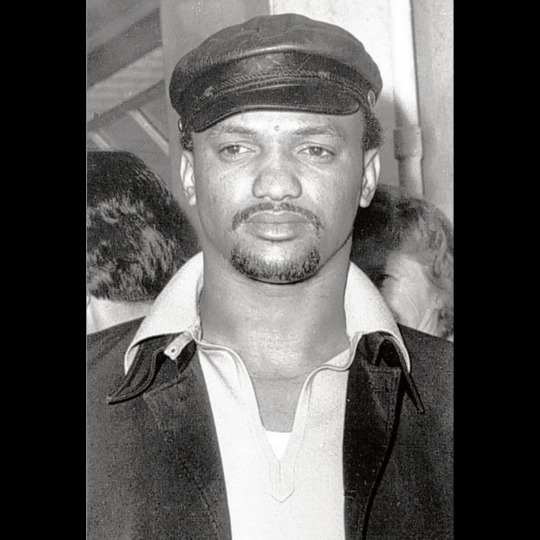
The original Black Panther Party and “Geronimo" Pratt connected at UCLA.
“Geronimo" Pratt, a Vietnam veteran, attend UCLA using the GI Bill. As a long-range reconnaissance expert with the 82nd Airborne, “Geronimo" Pratt served two tours of duty in Vietnam. He was awarded a Purple Heart and a Silver Star, and three years later left the military with the rank of sergeant. At UCLA is where he befriended Alprentice "Bunchy" Carter and gained insight into the Black Panther Party.
Growing up in Louisiana, he was very familiar with the sights of lychings and overt acts of racism, so the decision to become involved with the Black Panther Party came quite easily. He moved to Los Angeles in 1968 to attend UCLA and there he met Alprentice "Bunchy" Carter, who would give him the nickname "Geronimo." He was able to use his military background to train Black Panthers. He was labeled a hero, after raid by the LAPD newly deployed SWAT (Special Weapons and Tactics, a militarized police unit) and the four-hour shootout that took place at the Southern California Headquarters of the Black Panther Party on December 8, 1969 resulted in no deaths of any Black Panthers. The L.A. Black Panthers, under “Geronimo” Pratt's leadership, stood their ground. After over 5,000 rounds of ammunition had been exchanged with the police the Black Panthers surrender, alive.
The original Black Panther Party, founded by Bobby Seale and Huey Newton in Oakland, Calif., in 1966, was targeted by the late FBI Director J. Edgar Hoover in the FBI's COINTELPRO operations. Under the FBI’s COINTELPRO operation, infiltrators where sent into Black Panther Party gatherings to recruited informants. One of them, Julius Butler, was the key witness against “Geronimo" Pratt when he was charged in 1968 with the Santa Monica tennis court shooting of school teacher Caroline Olson. As a victim of COINTELPRO tactics "Geronimo" Pratt, was convicted and imprisoned for twenty-seven years on a California murder conviction that was later overturned.
The FBI's director J. Edgar Hoover became involved in stopping the original Black Panther Party as the party began to gain prominence during 1967 & 68. As COINTELPRO had been established in 1956 to police "political radicals" within the United States, focus and pressure now came onto the original Black Panther Party. On December 15, 1968, J. Edgar Hoover declared, "the Black Panther Party, without question, represents the "…greatest threat to the internal security of the country"; he pledged that 1969 would be the last year of the Party's existence. Agents were assigned to "expose, disrupt, misdirect, or otherwise neutralize the activities of black nationalists," Hoover said in a once-classified memo to field agents.
“Geronimo" Pratt, said he was innocent and maintained there were audiotapes that would prove the day of the killing he had been at a Black Panther Party meeting in Oakland. According to his lawyers, the police and the FBI hid and in turn, possibly destroyed wiretap evidence from the Black Panther Party meeting, which they had under surveillance. His lawyers, Johnnie L. Cochran and Stuart Hanlon, were relentless in filling filed new motions and pursuing his case and in 1997 they won.
Superior Court Judge Everett Dickey granted “Geronimo" Pratt a new trial, stating that the credibility of prosecution witness Butler, who testified “Geronimo" Pratt had confessed to him, could have been discredited if the jury had known about Butler’s relationship with law enforcement. Johnnie L. Cochran, called the day “Geronimo" Pratt's freedom was secured "the happiest day of my life practicing law." Within two years, LA prosecutors announced that they would abandon efforts to retry “Geronimo" Pratt and yet still they refused to acknowledged the he had been wrongly convicted.
In 2000, “Geronimo" Pratt settled a false imprisonment and civil rights lawsuit against city of Los Angeles and the FBI for $4.5. The FBI’s share was $1.75 million, marking one of the few times in its history that the nation’s top law enforcement agency was forced to admit culpability in a case of false imprisonment.
All Power To All The People!
Bobby Seale
http://bobbyseale.com/
=======
3 notes
·
View notes
Text
Events 1.17
38 BC – Octavian divorces his wife Scribonia and marries Livia Drusilla, ending the fragile peace between the Second Triumvirate and Sextus Pompey.
1362 – Saint Marcellus' flood kills at least 25,000 people on the shores of the North Sea.
1377 – Pope Gregory XI reaches Rome, after deciding to move the Papacy back to Rome from Avignon.
1524 – Giovanni da Verrazzano sets sail westward from Madeira to find a sea route to the Pacific Ocean.
1562 – France grants religious toleration to the Huguenots in the Edict of Saint-Germain.
1595 – During the French Wars of Religion, Henry IV of France declares war on Spain.
1608 – Emperor Susenyos I of Ethiopia surprises an Oromo army at Ebenat; his army reportedly kills 12,000 Oromo at the cost of 400 of his men.
1648 – England's Long Parliament passes the "Vote of No Addresses", breaking off negotiations with King Charles I and thereby setting the scene for the second phase of the English Civil War.
1773 – Captain James Cook leads the first expedition to sail south of the Antarctic Circle.
1781 – American Revolutionary War: Battle of Cowpens: Continental troops under Brigadier General Daniel Morgan defeat British forces under Lieutenant Colonel Banastre Tarleton at the battle in South Carolina.
1799 – Maltese patriot Dun Mikiel Xerri, along with a number of other patriots, is executed.
1811 – Mexican War of Independence: In the Battle of Calderón Bridge, a heavily outnumbered Spanish force of 6,000 troops defeats nearly 100,000 Mexican revolutionaries.
1852 – The United Kingdom signs the Sand River Convention with the South African Republic.
1873 – A group of Modoc warriors defeats the United States Army in the First Battle of the Stronghold, part of the Modoc War.
1885 – A British force defeats a large Dervish army at the Battle of Abu Klea in the Sudan.
1893 – Lorrin A. Thurston, along with the Citizens' Committee of Public Safety, led the Overthrow of the Kingdom of Hawaii and the government of Queen Liliʻuokalani.
1899 – The United States takes possession of Wake Island in the Pacific Ocean.
1903 – El Yunque National Forest in Puerto Rico becomes part of the United States National Forest System as the Luquillo Forest Reserve.
1904 – Anton Chekhov's The Cherry Orchard receives its premiere performance at the Moscow Art Theatre.
1912 – British polar explorer Captain Robert Falcon Scott reaches the South Pole, one month after Roald Amundsen.
1915 – Russia defeats Ottoman Turkey in the Battle of Sarikamish during the Caucasus Campaign of World War I.
1917 – The United States pays Denmark $25 million for the Virgin Islands.
1918 – Finnish Civil War: The first serious battles take place between the Red Guards and the White Guard.
1920 – Alcohol Prohibition begins in the United States as the Volstead Act goes into effect.
1941 – Franco-Thai War: Vichy French forces inflict a decisive defeat over the Royal Thai Navy.
1943 – World War II: Greek submarine Papanikolis captures the 200-ton sailing vessel Agios Stefanos and mans her with part of her crew.
1944 – World War II: Allied forces launch the first of four assaults on Monte Cassino with the intention of breaking through the Winter Line and seizing Rome, an effort that would ultimately take four months and cost 105,000 Allied casualties.
1945 – World War II: The Vistula–Oder Offensive forces German troops out of Warsaw.
1945 – The SS-Totenkopfverbände begin the evacuation of the Auschwitz concentration camp as Soviet forces close in.
1945 – Swedish diplomat Raoul Wallenberg is taken into Soviet custody while in Hungary; he is never publicly seen again.
1946 – The UN Security Council holds its first session.
1948 – The Renville Agreement between the Netherlands and Indonesia is ratified.
1950 – The Great Brink's Robbery: Eleven thieves steal more than $2 million from an armored car company's offices in Boston.
1950 – United Nations Security Council Resolution 79 relating to arms control is adopted.
1961 – U.S. President Dwight D. Eisenhower delivers a televised farewell address to the nation three days before leaving office, in which he warns against the accumulation of power by the "military–industrial complex" as well as the dangers of massive spending, especially deficit spending.
1961 – Former Congolese Prime Minister Patrice Lumumba is murdered in circumstances suggesting the support and complicity of the governments of Belgium and the United States.
1966 – Palomares incident: A B-52 bomber collides with a KC-135 Stratotanker over Spain, killing seven airmen, and dropping three 70-kiloton nuclear bombs near the town of Palomares and another one into the sea.
1969 – Black Panther Party members Bunchy Carter and John Huggins are killed during a meeting in Campbell Hall on the campus of UCLA.
1977 – Capital punishment in the United States resumes after a ten-year hiatus, as convicted murderer Gary Gilmore is executed by firing squad in Utah.
1981 – President of the Philippines Ferdinand Marcos lifts martial law eight years and five months after declaring it.
1991 – Gulf War: Operation Desert Storm begins early in the morning as aircraft strike positions across Iraq, it is also the first major combat sortie for the F-117. LCDR Scott Speicher's F/A-18C Hornet from VFA-81 is shot down by a Mig-25 and is the first American casualty of the War. Iraq fires eight Scud missiles into Israel in an unsuccessful bid to provoke Israeli retaliation.
1991 – Crown prince Harald V of Norway becomes King Harald V, following the death of his father, King Olav V.
1992 – During a visit to South Korea, Japanese Prime Minister Kiichi Miyazawa apologizes for forcing Korean women into sexual slavery during World War II.
1994 – The 6.7 Mw Northridge earthquake shakes the Greater Los Angeles Area with a maximum Mercalli intensity of IX (Violent), leaving 57 people dead and more than 8,700 injured.
1995 – The 6.9 Mw Great Hanshin earthquake shakes the southern Hyōgo Prefecture with a maximum Shindo of VII, leaving 5,502–6,434 people dead, and 251,301–310,000 displaced.
1996 – The Czech Republic applies for membership of the European Union.
1997 – Cape Canaveral Air Force Station: A Delta II carrying the GPS IIR-1 satellite explodes 13 seconds after launch, dropping 250 tons of burning rocket remains around the launch pad.
1998 – Lewinsky scandal: Matt Drudge breaks the story of the Bill Clinton–Monica Lewinsky affair on his Drudge Report website.
2002 – Mount Nyiragongo erupts in the Democratic Republic of the Congo, displacing an estimated 400,000 people.
2007 – The Doomsday Clock is set to five minutes to midnight in response to North Korea's nuclear testing.
2010 – Rioting begins between Muslim and Christian groups in Jos, Nigeria, results in at least 200 deaths.
1 note
·
View note
Video
youtube
Slauson Village member on subsets, White conflict & Bunchy Carter during...
0 notes
Photo

Los Angeles: Learn more about the Socialist Unity Party while celebrating Juneteenth.
Meet at 11 am at Tragniew Park in Compton on Saturday, June 20. Be ready to work. Wear long pants and sleeves as we will be cleaning up the Historic Compton Graveyard where Black Panther Bunchy Carter was laid to rest after the meeting.
#Los Angeles#Compton#Juneteenth#SUP#Struggle La Lucha#communist#socialism#revolution#Marxism#BlackLivesMatter#Black Panthers#Bunchy Carter
8 notes
·
View notes